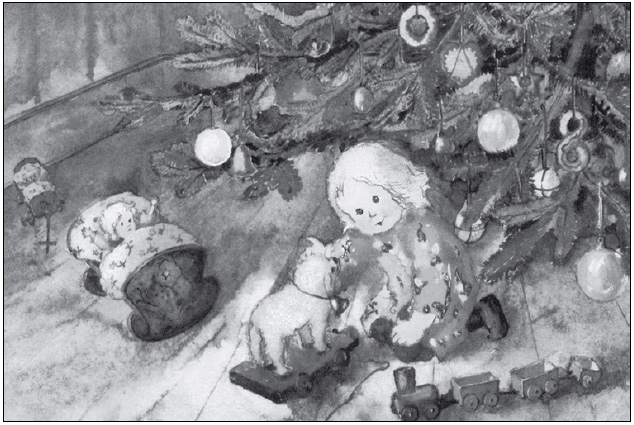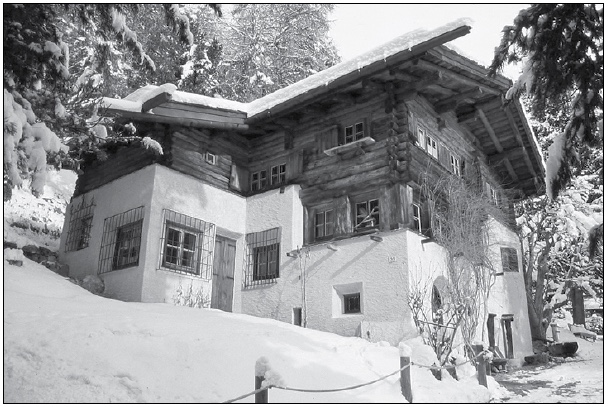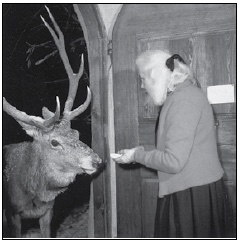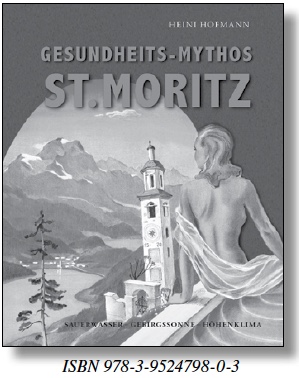Painted reverence for the creation
Painted reverence for the creation
100 years Mili-Weber-House – an oasis of arts in the forest above St Moritz
by Heini Hofmann
One feels placed in a dreamy counterworld to the classy Engadin jet set spa town. In the forest above the lake of St Moritz, surrounded by Swiss pines and larchs, the Mili-Weber-House is located, shelter of an art of soft tones, fairy-tale-like outside and inside, a true complete artwork.
Myriads of art enthusiasts but as well famous people among the St. Moritz jet set-guests honoured the Mili-Weber-House with their visit over the years, beginning with Farah Diba to the Sheik of Kuwait to Charlie Chaplin. Now it’s centenary is celebrated.
Elder sister as mentor
In the bi-lingual métropole of the Bernese Seeland, Berta Emilie called Mili was born 1 March 1891 as nestling in a well sheltered childhood about which she romanticised later: “All over the world nobody – really nobody – has such loving parents, good sisters and loving brothers”. Although the family’s life was not a bed of roses, they tried to foster the talents of the children so that in the end four of six dedicated themselves to painting, sculpture and architecture.
The real mentor of Mili, however, was her half-sister Anna Haller (1872–1924), about her she later said: “She was my one and only. I adored and admired her – she was so wise and so good”. The 19 years older Anna, who had passed the arts-and-craft class of the technical school Biel newly created in 1887 as the first woman, already was a successful artisan and painter and at the same time the first female teacher at the arts-and-craft class of the technical school Biel.
Although Mili had the only wish to follow suit her sister, she let herself be convinced by her to learn first a “real” profession.
So Mili became a kindergarten teacher, and this at the new girls’ school in Berne whose president was Rudolf von Tavel whose books meant a lot to her and of whose “so nice, beautiful tales” she liked to paint scenes.

Biel – Munich – St Moritz
So it didn’t take a long time until Mili definitively returned to painting. Anna gave her a paint box with oil colours and introduced her to a companioned painter who prescient predicted she would either stick at portraits and figure painting or she would go “into fairy tales”. To be able to bring her technical knowledge to perfection, her sister Anna took her along to Munich where she herself had got a big order by a publisher.
Mili’s education in Munich was paid from the estate of her brother Otto who was killed in an accident in the mountains. It was noble-minded left to her by her parents and siblings. Mili’s art teacher in Munich was an Austrian, cordial and encouraging: “You are a human being and I am a human being. You have your opinion and I have my opinion, I only show you the mistakes”. But suddenly – the summer 1914 approached – it was talk about war. Just when the two sisters had returned to Biel, the First World War broke out. All the delightful stuck in memory.
But painting went on, more intensive than ever. Besides orders for children’s portraits Mili began to paint small fairy tale watercolour paintings – elves and mushrooms with children’s faces – similar to the flower fairy tales of the Thurgau painter and children’s book illustrator Ernst Kreidolf, although not influenced by him.
The youngest brother Emil was at that time architect at the building contractor Nicolaus Hartmann in St Moritz, constructor of the Segantini and Engadin museum as well as the manager’s office of the Rhaetian railway in Chur (for this the brother Otto, killed in an accident, who had been a sculptor had created monumental sculptures whose discounted honorariums enabled Mili’s study visit in Munich). This reference and the fact that Anna Haller suffered from breathing problems, lead the family to transfer their place of residence to St Moritz in 1917; hundred years ago. But the mother should not live to see this relocation.
Joyful fairy tales without violence
The publishers Anna worked for, increasingly became aware of Mili so that she got commissions, too. Besides portraits and watercolour paintings she created colouring books of Grimm’s fairy tales, wall paintings and series of postcards. The house at the Via Dimlej built by her youngest brother became the ideal whereabouts for Mili full of tranquillity and inspiration. Increasingly she dedicated herself to the fairy tale theme and painted them in soft hues interpreted in her own way: Joyful fairy tales without violence and cruelty.
But there were repeated caesura in the life of Mili Weber, so when in 1924 her beloved sister and mentor Anna died, “I was of one mind with her”. Such strokes of fate as well as later the quiet years in the Engadin during the Second World War, the death of her father and this of her last brother who had actively supported her let become her creative work yet more intensive.
Therefrom the moving watercolour paintings, the profound picture stories, the fancifully miniatures of these years bear witness but likewise the paintings with which Mili changed walls, ceilings, timbers and furniture, even the house organ and bathrooms into a unique world of fairy tales. This artistic synthesis, just newly maintained by Si-bylla Degiacomi, captures today’s visitors as well and lets gape them like young children about so much quiet grandeur.
Quiet farewell
An eye complaint increasingly made painting impossible for her because a grey fog blurred the colours. But she retained her friendly-sunny smile and to the question if she wasn’t depressed not being able to see her own paintings she serenely answered that she carried them under her heart.
Thanks to the donation she had founded during her lifetime this “art house in the forest” remains preserved for the after-world. Quiet and gentle as she had lived Mili Weber died 11 July 1978 in the age of 87 in her fairy-tale-house. Her complete artwork is and will remain painted reverence for the creation and love to creature.•
The Mili-Weber-House at the Via Dimlej 35 in 7500 St Moritz can only be visited with a guide and upon prior reservation (maximum 8 persons at a time): phone 0041 79/53 99 777.
(Translation Current Concerns)

St Moritz above the lake. (Picture Mili-Weber-Foundation)
Her friends, the animals of the forest

HH. Mili Weber recharged her batteries for her work in nature, with which she was closely connected. This also proves her approach to the animals of the forest. The little deer Fin, which she bred and to whom she dedicated a story in book form, later came back to visit her with his offspring. Additionally, other roe deer and even stags, but also squirrels and birds gathered around her house and got their delicacies. Some of them, including even a capital stag with expanding antlers, sometimes followed her even into the hallway and kitchen. In one of her last letters, she wrote: “This way I live here on my own and the animals of the forest are my friends and companions.”
Dreamworlds of inspired nature
HH. The fairy tale world of the Engadin high valley, which has already inspired other famous painters, may have also stimulated Mili Weber. In addition, she was the warmth herself, as well towards the fellow human beings as towards nature and their creatures, which is unmistakably reflected in her work. Following human desire fantasies, she animates the nature with children’s figures in her paintings, initially in the form of personalised flowers.
Later, the little figures with their round heads and big, amazed eyes mutate into actual “little souls”, such as the “Kirschenkinder” or “Das Nixlein Sonnenschein” – mixtures of the most exact observation of nature and native-naive fantasy, innocent dream worlds that retrieve the viewer back to childlike amazement.
Symbols of the wisdom of life as well as characters from history and legends appear in all periods of Mili Weber’s work, such as the “Marienkind” or “Jeanne d’Arc”. Besides individual pictures, she also created groups of pictures (such as “Snow White and the Seven Dwarfs”) or picture stories (such as “Das Märlein vom gefangenen Königssohn”, in which even rock cunts are animated).
Whether drawings, watercolours or oil paintings, whether sculptures and miniatures (for her room-filling, castle-like doll’s house), whether picture- or book texts or music compositions for the house organ – everything that this peculiar and unique artist has created is perfused by her very own, nature-loving worldview, which in the polarities of life always leads from evil to good and from shadow to light. A message that should perhaps be noticed again today!
A moving book!

cc. It is not common that a nonfiction book on regional themes is revised and updated in its third edition. The “Gesundheitsmythos St. Moritz” (“Health myth of St Moritz”) by the publicist Heini Hofmann (who has also published in Current Concerns) managed to do so, because in writing and image he objectively analysed the past and at the same time visionary looks into the future. The former spa director of St Moritz, Hans Peter Danuser von Platen, describes it as “The best book ever written about St Moritz”.
Hoffmann, Heini. Gesundheitsmythos St. Moritz. Sauerwasser, Gebirgssonne, Höhenklima. (Health myth St Moritz. Sour water, mountain sun, mountain climate.) 456 pages, over 440 mostly coloured pictures, format 23x28 cm, cloth cover, dust jacket. Gammerter Druck und Verlag AG, St. Moritz, CHF 75.00